
WEED IT & REAP
Creating a heaven on Earth
Father Christopher Vasko tends garden at Historic St. Patrick's Church
6/4/2014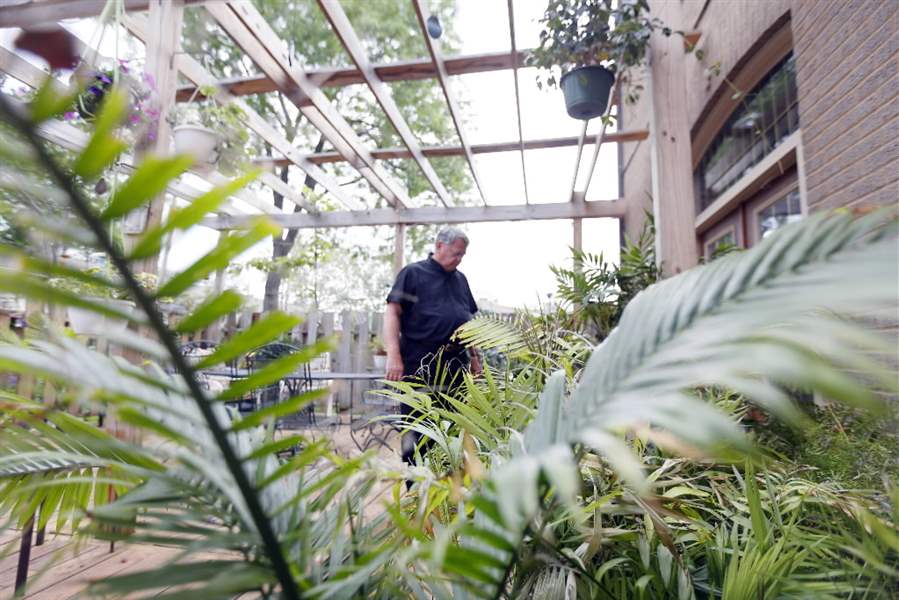
Father Christopher Vasko is seen between two Royal palms on his large deck.
THE BLADE/AMY E. VOIGT
Buy This Image
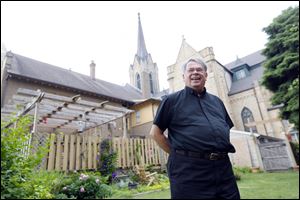
Father Christopher Vasko, judicial vicar for the Toledo Diocese (judging disputes based on Catholic church laws, such as marriage annulments), and pastor at Historic St. Patrick Church and Immaculate Conception parishes, living and gardening at St. Patrick on the southern edge of downtown.
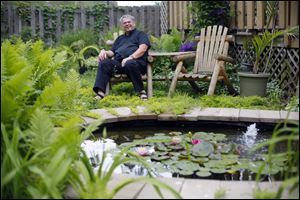
Rev. Vasko starts and ends his day near the pond.
Father Christopher Vasko has lived in the stately rectory at Historic St. Patrick Church for nine years and has been its pastor, also serving Immaculate Conception Church, for one year.
Opened in 1863 to serve Irish immigrants, St. Patrick was a 56-by-125-foot brick building at Lafayette and 13th streets.
In 1892, the foundation for a majestic new church was laid and allowed to settle for a year. The Gothic exterior was chiseled from Amherst blue sandstone from Loraine, a durable, fire-resistant stone. Nine years later, it was dedicated with great pomp, the altar splendid with roses, lilies, ferns, azaleas, and vines, all of which Fr. Vasko grows in the shadow of this stunning edifice. Its roof is crowned with a relatively new steeple and is home to a pair of peregrine falcons, regular visitors to Fr. Vasko’s backyard pond.
The church flies Irish and American flags and many of its 500-member families, nostalgic for the auld sod, drive in from around the region for Sunday Mass.
The church and its buildings are bordered on one side by the north-easternmost bit of the Anthony Wayne Trail, Toledo Mirror & Glass on another, and on two sides by the 159-unit Port Lawrence Homes housing project, whose residents are often young, poor, and transient families.

Climbing roses.
Fr. Vasko knows gardening builds community, from having passersby join him when he‘s weeding out in front, to the many meals shared on the large deck he has packed with floral beauty.
When two parishes in Lima were concerned their churches would be shuttered after he became pastor for both, he established friendship gardens, having each parish plant a garden for the other. Then, he put a dawn redwood next to each church. “And I said this tree will last 1,000 years and I think you’re going to be here for a while.”
PHOTO GALLERY: Father Vasko gives a tour of the garden
Garden dimensions:
I expanded the deck to about 20-by-40-feet and it’s ringed with plants of all sizes, several overhead windchimes, and a few gargoyles.
Behind the deck there’s a pond, a floral area outside the deck, and a new 20-by-20-foot bed.
When did you start gardening?
We (seven kids) were raised to be gardeners. We had an old farmhouse on almost an acre that got surrounded by Swanton. Our mom grew flowers and cactus (we learned to overwinter plants) and our dad grew vegetables. You could work in the garden if you liked it. I, a brother, and a sister loved to play in the dirt.
I had my first water garden in seventh grade. My parents let us do all kinds of crazy stuff. We dug a huge hole, built the frames, poured concrete, and stocked it with goldfish. We let neighborhood kids fish and if they caught a goldfish they could keep it.
When I was ordained 30 years ago, we had an outreach program in Delphos, Oh. for unemployed people to teach them how to grow and preserve food. It was two acres of rock-hard clay. The people didn’t like it so I ended up doing it. We had a huge potato patch for which we just laid potatoes on the ground and covered them up with five or six inches of straw, which holds water beautifully. You keep adding straw as the potato vines grow and they’re easy to retrieve when mature.
What do you grow?
Herbs (I love cooking with this stuff), tomatoes, and annuals on the deck. In the yard, daylilies and ferns, cleome that reseeds, and various kinds of sedum in between rocks.
This winter’s casualties include shasta daisies, some grape vines, butterfly bush, clematis, and rose bushes. There’s growth at the base of the roses, including the pale yellow St. Patrick roses next to the fence and house, but it remains to be seen whether the flowers will revert to the pre-grafted rootstock.
I have a climbing rose that makes large hips that I pick, cook into a nice syrup, and add to a bread recipe; you get an almost pink bread.
I put a Yukon gold potato with eyes in a pot.
We’re the highest point in Toledo, on a ridge, and the freezing wind was beating up three rhododendrons and three azaleas out front. I moved them into the backyard and they’re starting to flourish.
I’ve got some wine grapes; I’ll usually make five gallons at a time. I made a gorgeous, bright orange pineapple wine but it’s very acidic. Last autumn I made delicious blueberry wine from berries that had been donated to our food pantry and were going bad.
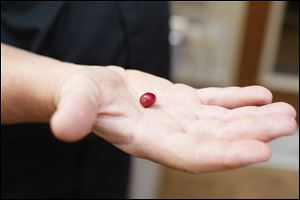
The ‘cherry’ of a coffee plant.
Favorite plant:
Water lilies; they and the water are just so calming. It’s great to sit out here very early in the morning. In the evening I’ll come out and listen to the [Cleveland] Indians.
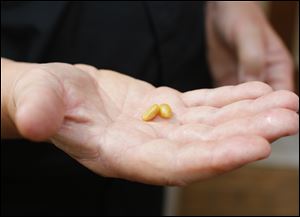
The beans of a coffee plant.
Give us a tip:
I overwinter about 50 plants in sunny windows and in the basement on shelves and hooks where they’re exposed to a strong lamp. When I bring them out in spring, I set them in the shade for about a week to get used to natural light. Among them are a shiny-leafed coffee plant. I roast the arabica beans in a hot-air popcorn popper; I like a dark roast. I get enough for a pot each year. They’ll flower soon. In winter, I park it next to a south-facing window.
My ‘palm oasis’ includes date, cat, and royal palms, some of which were used to decorate the church at Easter. The seed of cat palms start readily and look good in small pots so I often give them as gifts.
Geranium, Boston ferns, purple and green shamrock plants, vines, begonias. They may not look terrific in spring, but most will make a great comeback.
Another tip: Save the roots of ornamental sweet potato vines and pot them in early March. You can also propagate them by pinching off a piece of vine as small as an inch: stick it in dirt and keep it moist until it establishes roots.
Yet another: Save the soil from poinsettia plants. It’s highly fertilized and good for starting seeds. Poinsettia is also an attractive plant in the garden.
One last tip: If there’s something I don’t want kids messing with, I tell them, “Be careful, that’s poison ivy.”
Hours spent gardening per week?
About 15 hours. I try to do something every evening.
Annual expense:
$250-$300 for impatiens, petunias, marigolds.
Challenges:
Not having enough time to keep up with all the trimming and deadheading. Also, I’m nervous about seagulls or a great blue heron getting the koi and goldfish from my pond. The falcon pair that nests on the top of the church visit the pond often but don’t bother the fish.
I’m proud of:
How nice it makes a bunch of old wood [the deck] look.That’s the great blessing of all the time you spend, to give life to a place. We have a huge group of volunteers and a small paid staff, so we have lots of barbecues on the deck which is great for building community. I host the retired priests for dinner on Tuesdays.
What do you get out of gardening:
Besides sore knees? To treasure growing things. I hate to see any plant thrown away and I usually rescue them. After plants in the church are beyond their peak, the people who take care of the church give them to me ... I enjoy the beauty of just a simple green leaf … The satisfaction of seeing something you’ve done yourself.
A humorous story?
The other day I was watering the garden and a kid asked through the fence if he could water my plants. I gave him the hose and the first thing he did was water me. I said, “Oh, I’m all wet, my mom won’t let me in the house now.” He said, “For real?”
Contact Tahree Lane at: tlane@theblade.com or 419-724-6075.